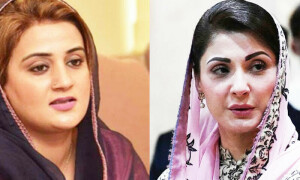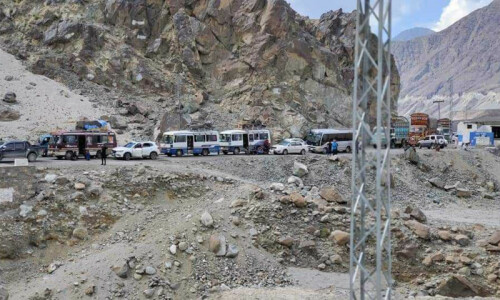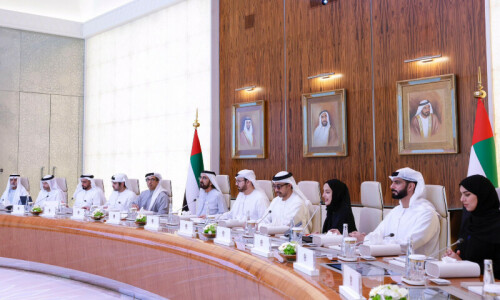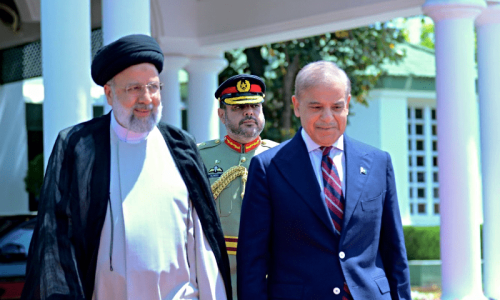ISLAMABAD: The International Monetary Fund (IMF) on Tuesday forecast inadequate growth rate of four per cent for Pakistan coupled with elevated rate of inflation and stubborn unemployment rate during the current fiscal year.
This growth rate is exactly the same as projected by the Asian Development Bank (ADB) about two weeks ago and significantly higher than 3.4pc forecast by the World Bank a few days ago, which was rejected by the government as unrealistic.
Fitch Solutions had projected Pakistan’s growth rate at 4.2pc which was significantly lower than the budgeted target of 4.8pc. The State Bank of Pakistan has anticipated GDP growth at the higher side of 4-5pc.
Projects higher inflation, unemployment during current fiscal year
In its World Economic Outlook (WEO), the Washington-based lending agency projected the average rate of inflation at 8.5pc, current account deficit at 3.1pc of GDP and unemployment rate at 4.8pc during current fiscal year.
The IMF projected the economic growth rate recovering slowly to 5pc of GDP by FY2026, which it had estimated in April this year. It said the rate of inflation would slide to 8.5pc this year against 8.9pc last fiscal year but would rise again to 9.2pc by the end of next year.
The Fund expected the Consumer Price Index to slowly come down to 6.5pc by FY2026. It estimated current account deficit would rise from 0.6pc of GDP in FY2021 to 3.1pc next year (FY2022) and then reduce to 2.8pc by FY2026.
Global economy
The WEO projected global growth to grow 5.9pc in 2021 and 4.9pc in 2022 (0.1 percentage point lower for 2021 than in July 2021) with increasing risks to global economy and complex policy trade-offs.
“The global economic recovery is continuing, even as the pandemic resurges. The fault lines opened up by Covid-19 are looking more persistent — near-term divergences are expected to leave lasting imprints on medium-term performance,” the WEO noted.
However, IMF’s chief economist Gita Gopinath said the risks to economic prospects had increased and policy trade-offs become more complex.
“Compared to our July forecast, the global growth projection for 2021 has been revised down marginally to 5.9pc and is unchanged for 2022 at 4.9pc,” she said, noting that modest headline revision masked large downgrades for some countries. “The outlook for the low-income developing country group has darkened considerably due to worsening pandemic dynamics.”
The downgrade also reflects more difficult near-term prospects for the advanced economy group, in part due to supply disruptions. Partially offsetting these changes, projections for some commodity exporters have been upgraded on the back of rising commodity prices. Pandemic-related disruptions to contact-intensive sectors have caused the labour market recovery to significantly lag the output recovery in most countries.
If Covid-19 were to have a prolonged impact — into the medium-term — it could reduce global GDP by a cumulative $5.3 trillion over the next five years. Therefore, the global community must step up efforts to ensure equitable vaccine access for every country, overcome vaccine hesitancy and secure better economic prospects for all, Mr Gopinath said.
“The dangerous divergence in economic prospects across countries remains a major concern,” she noted, expecting the aggregate output for the advanced economy group to regain its pre-pandemic trend path in 2022 and exceed it by 0.9pc in 2024. By contrast, aggregate output for the emerging market and developing economy group (excluding China) is expected to remain 5.5pc below the pre-pandemic forecast in 2024, resulting in a larger setback to improvements in their living standards.
These divergences are a consequence of the ‘great vaccine divide’ and large disparities in policy support. While over 60pc of the population in advanced economies are fully vaccinated and some are now receiving booster shots, about 96pc of the population in low-income countries remain unvaccinated.
Furthermore, many emerging market and developing economies, faced with tighter financing conditions and a greater risk of de-anchoring inflation expectations, are withdrawing policy support more quickly despite larger shortfalls in output.
Employment is generally expected to continue lagging the recovery in output. Global growth beyond 2022 is projected to moderate to about 3.3pc over the medium-term. Advanced economy output is forecast to exceed pre-pandemic medium-term projections, largely reflecting sizable anticipated further policy support in the United States that includes measures to increase potential.
The IMF called upon the international community to resolve trade tensions and reverse the trade restrictions implemented in 2018-19, strengthen the rules-based multilateral trading system, and complete an agreement on a global minimum for corporate taxes that halts a race to the bottom and helps bolster finances to fund critical public investments. At the national level, the policy mix should continue to be tailored to local pandemic and economic conditions, aiming for maximum sustainable employment while protecting the credibility of policy frameworks.
The IMF also advised the member countries to deal with the challenges of the post-pandemic economy: reversing the pandemic-induced setback to human capital accumulation, facilitating new growth opportunities related to green technology and digitalisation, reducing inequality and ensuring sustainable public finances.
The Fund also advised that building on the historic $650 billion Special Drawing Right (SDR) allocation, the countries with strong external positions should voluntarily channel their SDRs into the Poverty Reduction and Growth Trust.
Published in Dawn, October 13th, 2021















































